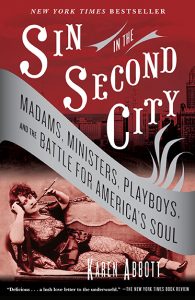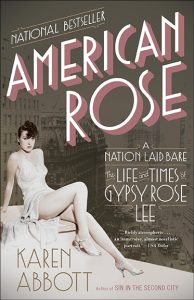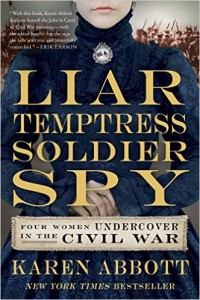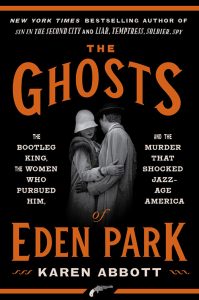Telling Women’s History: Three Questions and an Answer by Karen Abbott
Karen Abbott is the best-selling author of SIN IN THE SECOND CITY, AMERICAN ROSE, and, most recently, LIAR TEMPTRESS SOLDIER SPY, named one of the best books of 2014 by Library Journal, the Christian Science Monitor, and Amazon, and optioned by Sony for a miniseries. Her works to date have looked at women who function at the edges of society: brothel owners, striptease artist and Civil War spies.
I am so pleased that she was able to join us.
Take it away, Karen:
What’s your next book about and when is it coming out?
My next book is called THE GHOSTS OF EDEN PARK, and it’ll be published this October 8. It’s the incredible true story of America’s most successful bootlegger, George Remus—reportedly an inspiration for Jay Gatsby—who, by the summer of 1921, owned 35 percent of all the liquor in the United States. The press calls him “King of the Bootleggers,” writing breathless stories about the Gatsby-esque events he and his glamorous second wife, Imogene, host at their Cincinnati mansion, with party favors ranging from diamond jewelry for the men to brand new Pontiacs for the women. There’s also a badass woman district attorney, a sordid love triangle, and a sensational murder that perfectly captured the excesses and absurdities of the Jazz Age. I have never had so much fun writing a book.
What was the most surprisingly thing you’ve found doing historical research for your work?
A great question–and this gets to the heart of why research is the best part of the job. You’re a detective on the hunt, hoping that the next box or folder or envelope will yield an important clue, or a psychological insight into one of your characters. I’ve had memorable and lucky finds for all of my books. For SIN IN THE SECOND CITY, I went through the papers of the Everleigh sisters’ rival madam, Vic Shaw. Among them I found a business card belonging to one “Lil Kowalski.” She looked like the headmistress of a private school, all Victorian ruffles and tight chignon, but she was actually a “whipper,” in charge of disciplining the prostitutes on staff. The card said: “Lil the Whipper: beat 1,000 harlots bloody.” It was surreal, and a reminder of the cruelties of that time and place. For AMERICAN ROSE, it was the sheer—sometimes frightening—intensity of my conversations with Gypsy’s sister, June Havoc. I was the last writer to speak with her before she died, and many of our conversations had the feel of a confession. For LIAR TEMPTRESS SOLDIER SPY, I found one of the death threats received by Union spy Elizabeth Van Lew. The message was scrawled in red pencil and said: “Old Maid, your house is on fire. Give us some of your blood to write with.” I shivered right there in the rare books room of the New York Public Library; it was genuinely upsetting. I can’t imagine how terrified Van Lew herself felt reading that message back in 1864. And for THE GHOSTS OF EDEN PARK, I found the invitation George and Imogene Remus sent to 100 guests for their New Year’s Eve bash on December 31, 1921. Remus longed to be accepted by Cincinnati society, and invited them all to come—the Tafts, the Longworths, the Sintons—but none did. In a way, Remus later got his revenge. He was a very bizarre, innovative, and devilishly unpredictable character.
Your books are often compared to novels. Do you consciously use novelist’s tools in writing narrative history?
The truth is often stranger than fiction, and narrative nonfiction is, above all, about storytelling. Of course you hope to enlighten readers about a particular subject, but the main goal is to get them to turn the pages. So, yes, I use all of the novelist’s tools I possibly can: ending chapters or sections on a tense scene; foreshadowing; painting a descriptive picture of a time and place—what storefronts would characters have seen? What odors would they have smelled? Of course, I adhere to nonfiction’s constraints: you can’t invent anything, including dialogue and characters’ thoughts. If I’m lucky, I have a wealth of primary material to work with: diaries, letters, memoirs, interviews with contemporary newspapers—all of the things that let you report what you character said or felt in the moment. For THE GHOSTS OF EDEN PARK, I was incredibly lucky to find a murder trial transcript at Yale University. For seven days, from the library’s opening to its close, I sat at a huge overhead scanner and copied all 5,500 pages, one by one. It was a goldmine, and the book is much richer for it. Sometimes I’ll go back and reread certain passages of testimony, and feel transported—even just for a moment—back to 1927. Historical nonfiction writers are in the business of time travel, and it’s always a thrill to find your way back to the past.
And I’d like to ask you my favorite question that you asked me: What was the most surprising thing you found during your research? And, a bonus: who was the fiercest warrior of them all?
I must admit, I was constantly surprised writing Women Warriors because so much of it involved me working with historical periods that are very much not my field. But I was blown away by the story of Ani Pachen, a Tibetan nun who led her clan in armed resistance against the Chinese invasion of Tibet. I stumbled across her story when I had already finished the chapter that she belonged in. It was worth serious re-writing to include her.
As far as the most fierce warrior of them all goes: I would nominate Nakano Takeko, a woman of the samurai class who led a group of thirty women in a “forlorn hope” mission during the siege of Aizu in 1868. The world of the samurai was coming to an end and a number of samurai families were engaged in a bitter battle against the newly modernized forces of the Meiji emperor. Takeko and the other women confronted guns of the modern imperial army armed with swords and a traditional weapon known as a naginata. Despite the odds, they managed to do some damage before they were gunned down. Takeko took a bullet in the chest at the height of the battle. Dying, she asked her sister to cut off her head so no imperial soldier could take it as a trophy.
Ask me on another day, and I might nominate someone else.
Interested in learning more about Karen Abbott and her books?
Check out her website: https://karenabbott.net/
Follow her on Twitter: @KarenAbbott
[Come back tomorrow for the last episode of Telling Women’s History, when we’ll be talking to Katie Nelson and Olivia Miekle, hosts of the What’s Her Name podcast, which I listen to regularly every Monday night.]









